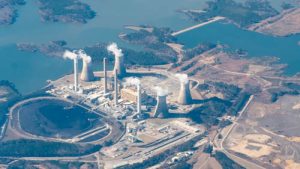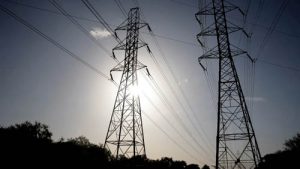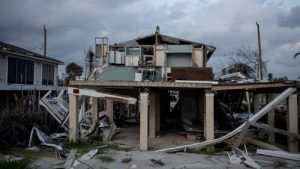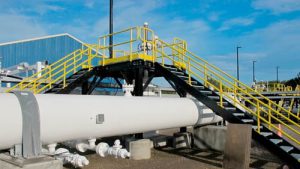Recent News
The Country’s First New Aluminum Smelter in 45 Years Could Cut Production Emissions by 75%
Century Aluminum Co. hopes half a billion dollars in federal funding will help it revive a dying industry while making it less polluting.
Aluminum is a crucial raw ingredient in the fight against climate change. But to ensure the transition off fossil fuels is a clean one, the industry needs a serious makeover. A new federally-funded “green smelter” could help make that happen.
Making this remarkably versatile metal requires a huge — and near-constant — supply of electricity. Much of it is generated by burning fossil fuels, which is one reason aluminum manufacturers are responsible for about 1.1 billion tons of carbon dioxide emissions a year. That’s more than twice the amount all of Australia spews annually.
Cleaning things up poses a huge challenge, one the Department of Energy, or DOE, wants to help solve. In March, the agency announced $6 billion in funding for “industrial demonstration” projects that showcase promising strategies for reducing the climate impact of heavy industry. The need is particularly acute, because heavy industrial processes like aluminum production generate nearly one-third of the country’s greenhouse gas emissions.
The beneficiaries of the government’s cleanup effort include Century Aluminum Company, which could receive up to half a billion dollars to build the nation’s first new aluminum smelter in 45 years. 05-03-24
New documents show oil executives promoted natural gas as green — but knew it wasn’t
It’s the first evidence of an oil company acknowledging that gas wasn’t as climate-friendly as promised.

U.S. Representative Jamie Raskin, a Democrat from Maryland, testifies during the Senate hearing on Capitol Hill on May 1. Brendan Smialowski / AFP via Getty Images
A congressional hearing on the fossil fuel industry’s “evolving efforts to avoid accountability for climate change” turned into a spectacle on Wednesday morning as lawmakers in Washington, D.C., grilled a panel of experts on wide-ranging — and often irrelevant — topics. The thousands of internal oil company documents released before the hearing, however, contained some bombshell findings.
One of the biggest revelations is that BP executives understood that natural gas, which the company promoted as a “bridge” or “destination” fuel to a cleaner future as coal declined, was incompatible with the goals of the Paris Agreement signed in 2015. “[O]nce built, gas locks in future emissions above a level consistent with 2 degrees,” at least without widespread carbon capture technology, according to a comment on a draft outline for a speech by BP’s CEO in 2017.
“This is the first evidence I’ve seen of them acknowledging internally, at the highest levels, that they know this — natural gas is a climate disaster — and yet, they still promote it,” said Richard Wiles, president of the Center for Climate Integrity, an environmental advocacy organization.
At Wednesday’s hearing, Senator Sheldon Whitehouse, a Democrat from Rhode Island, invited expert witnesses to talk about the industry’s attempts to shape media coverage and academic research and allegations that they misled the public through deceptive advertising. But Republican lawmakers went off-script, asking questions about boreal forest fires and alleging that reducing fossil fuel production would result in Americans “having to sell blood in order to pay their electricity bill.” 05-02-24
EPA Finally Takes on Abandoned Coal Ash Ponds — But it Might Be Too Late
Will utilities clean up toxic waste at power plants, or run out an election-year clock?
Last week, the EPA released a suite of long-awaited rules meant to cut down the carbon that the U.S. emits when generating electricity. The rules primarily target existing coal plants and new natural gas facilities, in many cases requiring dramatic emissions cuts that won’t be possible without an unprecedented deployment of carbon capture. (The new EPA proposals are part of an ongoing flurry of federal regulatory actions that must be issued by May 22 to minimize the possibility that they’ll be rolled back if Republican Donald Trump defeats President Biden in November’s election.)
The EPA’s new power sector rules have been widely scrutinized for their potential impact on the country’s electric utilities, which have lately been drawing up plans to expand natural gas capacity in response to the growing electricity demand promised by new industrial facilities, AI-supporting data centers, and electric vehicle adoption. However, last week’s rules also contained substantial new controls on the pollution generated by the nation’s aging fleet of coal-fired power plants — as well as the toxins left behind by the many that have already shuttered — including a proposal that closes a longstanding loophole in federal regulations governing the cleanup of coal ash, a toxic waste byproduct of the coal-fired power process.
The new rule builds on a landmark 2015 rule prohibiting coal ash from being permanently stored in places where it comes into contact with groundwater. This was meant to reform the widespread practice of creating so-called coal ash ponds where the toxin is stored in a wet slurry. While at that time the EPA only applied the rule to coal plants in active use, the new rule will require the cleanup of hundreds of “legacy” coal ash ponds. 05-01-24
Column: Climate Change is a Star in Some of Hollywood’s Most Popular Movies

A screen grab from the trailer for the 2021 film “Zack Snyder’s Justice League.” From left: Ray Fisher as Cyborg, Ezra Miller as The Flash, Ben Affleck as Batman, Henry Cavill as Superman, Gal Gadot as Wonder Woman and Jason Momoa as Aquaman.
(HBO Max)
I never saw the 2017 film “Justice League.” But if I had, I would have been treated to a scene in which Batman (Ben Affleck) tries to persuade Aquaman, Protector of the Oceans (Jason Momoa) to join his band of superheroes by referencing the climate crisis.
“Mankind’s melting the polar ice caps, destroying the ecosystem,” Batman warns.
“Hey, I don’t mind if the oceans rise,” Aquaman responds.
“How about if they boil?” Batman asks ominously.
That scene is a great example of how Hollywood movie and TV studios can keep climate change and clean energy solutions top of mind for audiences — and thus motivate people to take action — while also telling entertaining stories, according to a new report from Colby College’s Buck Lab for Climate and Environment and the nonprofit consulting firm Good Energy.
The report — shared with The Times ahead of its release Tuesday — examined 250 of the most popular films of the last decade, based on quantity of IMDb ratings. Researchers at Maine’s Colby and the University of Utah applied the newly developed Climate Reality Check — which measures whether a film and its characters acknowledge the existence of global warming — to the most frequently rated fictional movies set in present-day or near-future Earth and released from 2013 through 2022. 04-30-24
US Military Bases Teem With PFAS. There’s Still No Firm Plan to Clean Them Up.
Excessive levels of PFAS have been detected at 80 percent of active and decommissioned military bases.
In 2016, Tony Spaniola received a notice informing him that his family shouldn’t drink water drawn from the well at his lake home in Oscoda, Michigan. Over the course of several decades, the Air Force had showered thousands of gallons of firefighting foam onto the ground at Wurtsmith Air Force Base, which closed in 1993. Those chemicals eventually leached into the soil and began contaminating the groundwater.
Alarmed, Spaniola began looking into the problem. “The more I looked, the worse it got,” he said. Two years ago, his concern prompted him to co-found the Great Lakes PFAS Action network. The coalition of residents and activists is committed to making polluters, like the military and a factory making waterproof shoes, clean up the “forever chemicals” they’ve left behind.
PFAS, or per- and polyfluoroalkyl substances, are a class of nearly 15,000 fluorinated chemicals used since the 1950s to make clothing and food containers, among other things, oil- and water-repellent. They’re also used in firefighting foam. These chemicals do not break down over time, and have contaminated everything from drinking water to food. Research has linked them to cancer, heart and liver problems, developmental issues, and other ailments.
The U.S. Department of Defense, or DOD, is among the nation’s biggest users of firefighting foam and says 80 percent of active and decommissioned bases require clean up. Some locations, like Wurtsmith, recorded concentrations over 3,000 times higher than what the agency previously considered safe. 04-29-24
Why a “fracking refugee” is Attending the Global Plastics Treaty Negotiations
“Fracking and building pipelines in order to create more poisonous plastic is ruining people’s lives.”
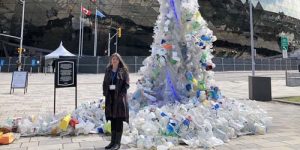
Jill Hunkler is pictured in front of the Shaw Centre, where the plastic treaty negotiations are taking place. Credit: Allison Woolverton.
Jill Hunkler, an Ohio resident who considers herself a “fracking refugee,” is telling her family’s story at the global plastics treaty negotiations in Ottawa this week, where negotiators from about 175 countries are working to advance a treaty to address global plastic pollution.
“I was forced to leave my home that I built with my own hands,” she told Environmental Health News. “I lived in Somerset Township, Ohio, where my sister, my mom and I had 13 acres of land and we had spent years building homes on it that we loved, but then 78 fracking well pads were built within five miles of our home.”
Air pollution from the fracking operations sickened her and her family, Hunkler said, and they experienced symptoms like headaches, nausea, rashes, body aches and difficulty breathing that they hadn’t experienced before the wells were drilled. The family tried to get help from regulators, but after years of suffering with little action, they opted to move.
Her family moved to another property, she said. “But eventually fracking showed up there too, and I moved again to try and escape it. So now I’m twice a fracking refugee.”
More than 99% of plastic is made from fossil fuels, and as the world transitions to renewable energy, fossil fuel companies — particularly those invested in fracking — are driving a new plastics boom to stay profitable. For example, in the Ohio River Valley, where Hunkler is from, Shell recently began operations at its massive Pennsylvania plastics plant that converts fracked ethane gas into plastic pellets, many of which are used to create single-use plastic products like bags and packaging. 04-26-24
Republican Attorneys General Mount a New Attack on the EPA’s Use of Civil Rights Law
23 states want the Biden administration’s EPA to curtail its approach to environmental justice.
For much of its 53-year history, the Environmental Protection Agency let civil rights complaints languish. From Flint, Michigan to the industrial corridors of the Deep South, communities attempting to use federal civil rights law to clean up the pollution in their neighborhoods were largely met with years of silence as their cases piled up in the agency’s backlog. That changed in 2020, after a federal judge ruled that the EPA must conduct timely investigations of civil rights complaints, and staffers began looking into cases where they identified potential discrimination.
Now, a slate of red-state attorneys generals are trying to stop the EPA from taking race into account at all. Twenty-three Republican attorneys general filed a petition with the Biden administration’s EPA last week asking the agency to stop using Title VI of the Civil Rights Act to regulate pollution. Advocates described the move, spearheaded by Florida’s Ashley Moody, as an attempt to strip the EPA of an avenue for tackling environmental justice, which the agency defines as “the just treatment and meaningful involvement of all people, regardless of income, race, color, national origin, Tribal affiliation, or disability, in agency decision-making.” In their petition, the Republican attorneys general argued that in practice, environmental justice “asks the States to engage in racial engineering.” 04-25-24
10 Times as Much of This Toxic Pesticide Could End Up on Your Tomatoes and Celery Under a New EPA Proposal

Photo illustration by Lauren Joseph/ProPublica. Source images by Cavan Images/Getty and Sirisak Boakaew/Getty.
Against the guidance of scientific advisory panels, the EPA is relying on industry-backed tests to relax regulations on acephate, which has been linked to neurodevelopmental disorders. “It’s exactly what we recommended against,” one panelist said.
When you bite into a piece of celery, there’s a fair chance that it will be coated with a thin film of a toxic pesticide called acephate.
The bug killer — also used on tomatoes, cranberries, Brussels sprouts and other fruits and vegetables — belongs to a class of compounds linked to autism, hyperactivity and reduced scores on intelligence tests in children.
But rather than banning the pesticide, as the European Union did more than 20 years ago, the U.S. Environmental Protection Agency recently proposed easing restrictions on acephate.
The federal agency’s assessment lays out a plan that would allow 10 times more acephate on food than is acceptable under the current limits. The proposal was based in large part on the results of a new battery of tests that are performed on disembodied cells rather than whole lab animals. After exposing groups of cells to the pesticide, the agency found “little to no evidence” that acephate and a chemical created when it breaks down in the body harm the developing brain, according to an August 2023 EPA document. 04-24-24
Biden’s ‘Solar for All’ Awards $7B to Bring Affordable Energy to Low-income Families
The program is designed to reduce greenhouse emissions and energy inequity.
 Clean energy, like so many commodities in this country, is neither distributed evenly nor equally. Disadvantaged communities have far fewer solar panels arrayed across their rooftops than areas with higher incomes. The federal government just took a major step toward crossing that chasm.
Clean energy, like so many commodities in this country, is neither distributed evenly nor equally. Disadvantaged communities have far fewer solar panels arrayed across their rooftops than areas with higher incomes. The federal government just took a major step toward crossing that chasm.
On Monday, President Joe Biden announced the 60 organizations that, under the administration’s Solar for All program, will receive a combined $7 billion in grants to bring residential solar into low-income neighborhoods. The funding will flow into state, municipal, and tribal governments as well as nonprofits to support existing programs for low-income solar and battery storage installations and spur new ones. Such efforts are expected to bring affordable clean energy to 900,000 households.
While the climate and environmental benefits of this effort are critical, the households poised to benefit will feel the most immediate impacts on their pocketbooks.
“Low income families can spend up to 30 percent of their paychecks on their energy bills,” Biden said while announcing the funding in Virginia. “It’s outrageous.” 04-23-24
California Communities are Fighting the Last Battery Recycling Plant in the West — and its Toxic Legacy
Lead battery recycling is a crucial but dirty business. As a plant outside Los Angeles seeks to renew its operating permit, the community pushes back.
West of the Rockies, just one lead battery recycler remains in the United States. If your car battery conks out in downtown Seattle or the Sonoran desert, it will probably be hauled to Ecobat, a lead smelter half an hour east of downtown Los Angeles.
Ecobat’s facility in City of Industry melts down 600 tons of batteries and scrap every day. A conveyor belt takes the batteries to a hammer mill where they’re cracked open and slammed into pieces. Then a furnace blasts them with 1,000 degrees of heat. The resulting ingots or “pigs” of lead then ride on, to become batteries once again.
Nationally, about 130 million car batteries meet this fate each year. Fewer than a dozen smelters do this work in the U.S. No other consumer product in the country closes its recycling loop so completely.
But the crucial business of smelting lead is also a very dirty one.
Lead is a neurotoxin; no known levels of it are safe. People who breathe airborne particles of lead or accidentally put it in their mouths — especially children — can suffer nerve disorders and developmental problems. 04-22-24
Taking Big Oil to Court For ‘climate homicide’ Isn’t as Far-fetched as it Sounds
Are fossil fuel companies guilty of actual murder?
A new legal theory suggests that oil companies could be taken to court for every kind of homicide in the United States, short of first-degree murder.
The idea of “climate homicide” is getting attention in law schools and district attorney’s offices around the country. A paper published in Harvard Environmental Law Review last week argues that fossil fuel companies have been “killing members of the public at an accelerating rate.” It says that oil giants’ awareness that their pollution could have lethal consequences solidly fits within the definition of homicide, which, in its basic form, is causing death with a “culpable mental state.” In other words, the case can be made that oil companies knew what they were doing.
“It’s sparking a lot of conversation,” said Aaron Regunberg, senior policy counsel at the advocacy group Public Citizen. After discussing the idea with elected officials and prosecutors, Regunberg said, many of them have moved from “‘Oh, that’s crazy’ to ‘Oh, that makes sense.’”
Starting around the 1970s, oil companies like Exxon understood the dangers that burning fossil fuels would unleash — unprecedented warming that would render parts of the globe “less habitable,” submerge coastal cities, and lead to extensive drought and mass famine. Yet instead of switching away from coal and oil, they doubled down, working to block legislation to reduce greenhouse gas emissions and spreading doubt about the science of climate change. Today, with atmospheric CO2 climbing to levels last seen 14 million years ago, the predicted consequences have begun to arrive. Since the start of the 21st century, climate change has killed roughly 4 million people, according to one conservative estimate. 04-19-24
No Birdsong, No Water in the Creek, No Beating Wings: How a Haven For Nature Fell Silent

Bernie Krause ‘out there and listening to the soundscapes’ in Sugarloaf Ridge state park. Photograph: Cayce Clifford/The Guardian
As the soundscape of the natural world began to disappear over 30 years, one man was listening and recording it all
Read more: World faces ‘deathly silence’ of nature as wildlife disappears, warn experts
The tale starts 30 years ago, when Bernie Krause made his first audio clip in Sugarloaf Ridge state park, 20 minutes’ drive from his house near San Francisco. He chose a spot near an old bigleaf maple. Many people loved this place: there was a creek and a scattering of picnic benches nearby.
As a soundscape recordist, Krause had travelled around the world listening to the planet. But in 1993 he turned his attention to what was happening on his doorstep. In his first recording, a stream of chortles, peeps and squeaks erupt from the animals that lived in the rich, scrubby habitat. His sensitive microphones captured the sounds of the creek, creatures rustling through undergrowth, and the songs of the spotted towhee, orange-crowned warbler, house wren and mourning dove.
Back then, Krause never thought of this as a form of data-gathering. He began recording ecosystem sounds simply because he found them beautiful and relaxing. Krause has ADHD and found no medication would work: “The only thing that relieved the anxiety was being out there and just listening to the soundscapes,” he says. 04-16-24
Who’s Afraid of a 300-mile Transmission Line That Could Help Decarbonize the Southeast?
Louisiana lawmakers and local utilities.
When a winter storm knocked out Texas’ power grid in 2021, the scale of the devastation it wrought was exacerbated by a singular fact about the Lone Star State: It has its own electric grid, an “energy island” that has long been uniquely isolated from the rest of the country, with just four transmission lines linking it to neighboring states. When the storm hit, Texas was unable to transfer enough emergency power from other electricity markets to keep the lights on. The death toll was in the hundreds.
A new multi-billion-dollar infrastructure project could mitigate a similar power emergency in the future. For more than a decade, a private renewables developer, Pattern Energy, has been trying to build a 320-mile transmission line linking Texas’ power grid to the Southeast. But the project, known as Southern Spirit, is now facing opposition in not one but two states it would traverse. Entergy, a utility company whose affiliates in Mississippi and Louisiana would stand to benefit if the new project fails, has raised doubts about the proposal before Mississippi regulators. And even if Mississippi moves forward, a bill in the Louisiana legislature — which was revised at the behest of Entergy — could derail the entire project.
It’s not just Texans who would benefit from more transmission. In order for the U.S. to decarbonize its electricity, a lot more power lines will need to be built across the country. Most crucial is the need for more interregional transmission lines like Southern Spirit — those that connect the nation’s patchwork of energy grids to one another. 04-17-24
FEMA is Making an Example of This Florida Boomtown. Locals Call it ‘revenge politics.’
The Biden administration is trying to punish Lee County for rebuilding flood-prone homes. The state’s Republican politicians are fighting back.
When U.S. homeowners buy subsidized flood insurance from the Federal Emergency Management Agency, they make a commitment to build back better after flood disasters, even if it costs them. FEMA’s notorious 50 percent rule stipulates that if a home in a flood zone suffers damages worth more than half its value, it must be torn down and rebuilt so it’s elevated above flood level. This can cost homeowners hundreds of thousands of dollars, but it prevents the American public from footing the bill for the repeated destruction of vulnerable homes — at least in theory.
Enforcement of the 50 percent rule largely falls to local officials in flood-damaged regions, who are charged with ensuring that their constituents aren’t rebuilding in flood zones. In exchange for this diligence, the federal government subsidizes low-cost flood insurance for homes in communities that certify their compliance with the rule, goosing red hot real estate markets in Florida and other scenic but climate-threatened regions.
As Florida continues rebuilding from 2022’s devastating Hurricane Ian, however, the Biden administration may be signaling that this era of easy money is over. Late last month, FEMA sent an explosive letter to local officials in Lee County, Florida, where over 750,000 people live near some of South Florida’s most prized coastal land. FEMA claimed that almost 600 homeowners in the city of Cape Coral and other nearby towns had rebuilt vulnerable homes in the flood zone over the 18 months since Hurricane Ian, violating the 50 percent rule as well as local construction laws. 04-16-24
Plastics Production on the Gulf Coast is Exploding. Here’s How to Respond

The Gulf Coast petrochemical industry, one of the most polluting industry complexes on Earth, has expanded in response to low natural gas prices. Source: Roschetzky Photography via Shutterstock
Even as the world suffers a plastics glut, petrochemical companies are prolonging the ‘plasticene era.’
The Gulf Coast petrochemical industry has big expansion plans for plastics production that threaten to undermine corporate efforts to reduce plastics use and waste as well as the international negotiations for the Global Global Plastics Treaty that will continue this month in Ottawa.
The looming plastics boom raises questions for sustainability professionals navigating plastics reduction targets about the efficacy of their own efforts as well as how they can respond to help end the world’s “plasticene era.”
Ten new plastics production plants and 17 expansion projects are planned over the next five years at Gulf Coast refineries, according to a new report by the Environmental Integrity Project (EIP). The proposed plants will emit up to 35.5 million tons of greenhouse gases annually along with large quantities of harmful air pollutants, further burdening communities already suffering from environmental and social injustices, authors say.
“The cumulative impact of the emissions [from these plants] is shocking, but what’s worse is that the financial markets are telling us … we may not even need a lot of these plants,” said Tom Sanzillo, director of financial analysis at the Institute of Energy Economics and Financial Analysis and a former deputy comptroller for New York State.
DOJ Thinks Enbridge Line 5 Pipeline is Trespassing on Tribal Lands
But the agency stopped short of telling company to move.
Those involved in the Line 5 pipeline controversy have been waiting for the United States Department of Justice — and the Biden administration — to come forward with its opinion on a case that involves tribal sovereignty and foreign relations.
But when the legal brief came down on Wednesday, no one was satisfied.
The Justice Department amicus brief backed claims from a Wisconsin tribe that Enbridge, a Canadian company, was trespassing on its lands by continuing to operate the Line 5 pipeline there. The 71-year-old pipeline carries up to 540,000 barrels of oil and natural gas liquids daily from Superior, Wisconsin to Sarnia, Ontario.
The DOJ also agreed that Enbridge has been trespassing on the band’s lands for over a decade, and specified the company should pay more than the court-ordered $5.15 million to the band, since the company has made over $1 billion in that time.
“We are grateful the U.S. urged the court not to let Enbridge profit from its unlawful trespass,” said Robert Blanchard, chairman of the Bad River Band of the Lake Superior Chippewa Indians, located in northern Wisconsin. 04-12-24
‘Simply Mind-boggling’: World Record Temperature Jump in Antarctic Raises Fears of Catastrophe

Thousands of emperor penguin chicks drowned last year when the sea-ice broke up before they could fully fledge. Photograph: Fritz Polking/Gamma-Rapho/Getty Images
An unprecedented leap of 38.5C in the coldest place on Earth is a harbinger of a disaster for humans and the local ecosystem
On 18 March, 2022, scientists at the Concordia research station on the east Antarctic plateau documented a remarkable event. They recorded the largest jump in temperature ever measured at a meteorological centre on Earth. According to their instruments, the region that day experienced a rise of 38.5C above its seasonal average: a world record.
This startling leap – in the coldest place on the planet – left polar researchers struggling for words to describe it. “It is simply mind-boggling,” said Prof Michael Meredith, science leader at the British Antarctic Survey. “In sub-zero temperatures such a massive leap is tolerable but if we had a 40C rise in the UK now that would take temperatures for a spring day to over 50C – and that would be deadly for the population.”
This amazement was shared by glaciologist Prof Martin Siegert, of the University of Exeter. “No one in our community thought that anything like this could ever happen. It is extraordinary and a real concern,” he told the Observer. “We are now having to wrestle with something that is completely unprecedented.”
Poleward winds, which previously made few inroads into the atmosphere above Antarctica, are now carrying more and more warm, moist air from lower latitudes – including Australia – deep into the continent, say scientists, and these have been blamed for the dramatic polar “heatwave” that hit Concordia. 04-06-24
EPA Finalizes the Nation’s First PFAS Limits in Drinking Water
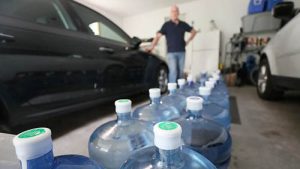
A family receives bottled water deliveries after high levels of PFAS were detected in their tap. Suzanne Kreiter/The Boston Globe via Getty Images
Although there are thousands of forever chemicals, the new regulation targets six of the most pervasive ones.
Some 70 years after they entered widespread chemical use, the federal government is finally regulating the so-called “forever chemicals” found in everything from nonstick cookware to menstrual products.
The Environmental Protection Agency on Wednesday announced the nation’s first drinking water standards for six types of per- and polyfluoroalkyl substances, known as PFAS. These long-lasting synthetic chemicals don’t break down naturally in the environment and have been linked to cancer, heart and liver problems, developmental damage, and other health issues.
Under the new rule, drinking water concentrations of two of the most thoroughly studied and prevalent of these substances — PFOA and PFOS — will be capped at the lowest limit that the EPA believes is technologically possible, about 4 parts per trillion, reflecting scientists’ understanding that there is no safe exposure level for them. Three other common PFAS will be limited to 10 parts per trillion, either measured on their own, in combination with each other, or with one otherwise unregulated chemical.
The compounds being regulated represent a fraction of the entire class of chemicals — more than 15,000 distinct variants fall under the PFAS umbrella. Still, the EPA estimates that its new rules will protect some 100 million people from exposure and prevent tens of thousands of serious illnesses, especially cancers. 04-10-24
Water From Arsenic-laced Wells Could Protect the Pine Ridge Reservation From Wildfires
“We’re looking to deal with extended drought and the increasing intensity of wildfires.”
With decades of experience, Reno Red Cloud knows more than anyone about water on the Pine Ridge Reservation in South Dakota. As climate change makes fire season on the reservation — which covers more than two million acres — more dangerous, he sees a growing need for water to fight those fires.
Red Cloud is the director of water resources for the Oglala Sioux Tribe and he recently received nearly $400,000 in federal funding to revive old wells that have been dormant for decades. He thinks the wells can produce over a million gallons of water a day. But there’s one catch: they have elevated levels of arsenic.
“We have to look at using these wells,” he said. “They are just sitting there. Instead of plugging them, like a band-aid, let’s utilize them for the future of drought mitigation.”
The Oglala Sioux’s water needs have doubled in recent years, with longer and hotter summers and, of course, drought. With more wildfires on the horizon, the water Red Cloud envisions could not only add to the quality of life for those on the reservation, but he sees this as a climate solution for reservations across the nation.
“We think other reservations could do the same,” he said.
Arsenic can’t be seen, smelled, or tasted. It is a natural element found in the upper parts of the earth’s crust, and while a big dose of it is fatal, the more common issue is consumption of low levels of arsenic over long periods of time. 04-09-24
Enviva bankruptcy fallout ripples through biomass industry, U.S. and EU
 The bankruptcy filing in March by Maryland-based Enviva — the world’s largest maker of wood pellets from forest biomass — is rattling a European Union that relies heavily on biomass as a significant though contested renewable energy source.
The bankruptcy filing in March by Maryland-based Enviva — the world’s largest maker of wood pellets from forest biomass — is rattling a European Union that relies heavily on biomass as a significant though contested renewable energy source.
The bankruptcy is also invigorating U.S. forest advocates determined to keep the Biden Administration from using new renewable energy credits to bail out the flailing company. On March 21, officials from five federal agencies visited North and South Carolina to see an Enviva pellet-making plant firsthand and hear environmental justice complaints over the impacts it is having on low-income communities.
But the company faces immediate threats to its ongoing viability that transcend its $2.6 billion debt and negative community impacts, according to a former maintenance manager at two Enviva pellet-making plants in North Carolina and Virgina between 2020 and 2022, and an exclusive Mongabay source.
As many as eight of Enviva’s 10 pellet mills in the U.S. Southeast, he said, are in such poor condition that they are producing fewer pellets monthly at a much higher cost due to intractable and costly maintenance issues.
“There’s no way Enviva is coming out of Chapter 11,” the former employee told Mongabay, referring to a court-ordered reorganization process by which the firm has a set time to restructure its debt and begin paying back creditors. “Their manufacturing equipment is not fit for the service it’s required to deliver. Only two of its 10 plants (one in Florida, one in Georgia, neither built by Enviva) are hitting their maximum achievable targets for pellet production.” 04-02-24
In Chicago, One Neighborhood is Fighting Gentrification and Climate Change at the Same Time
The secret to success? Build affordable housing next to transit.
Christian Diaz hates a boxy, six-story brick building with blue and gray paneling in Logan Square, a rapidly gentrifying neighborhood on the northwest side of Chicago.
“It looks boring and uninspired,” said Diaz, the housing director at Palenque LSNA, formerly known as the Logan Square Neighborhood Association. “When people think gentrification, this is the building that comes to mind.”
The building is an example of what urban planners call Transit-Oriented Development, or TOD. The idea is that developing near transit leads to interconnected communities and fewer cars emitting carbon dioxide. Developers get incentives and neighbors get a walkable community. But Diaz said buildings like this — dense, tall developments catering to wealthy tenants — are accelerating gentrification in the once working-class, largely Latino neighborhood. Only three of the 60 units qualify as affordable housing.
“This building, thumbs down — 100 percent thumbs down,” Diaz said.
Instead, housing advocates like Diaz want TOD to evolve and become a tool to make Logan Square accessible for everyone — and to help reclaim it for people pushed out by gentrification. 04-05-24
As Amazon Eliminates Plastic Packaging Abroad, It’s Using Even More in the US
A new report finds Amazon has reduced plastic packaging the most in countries with stringent regulations.
In response to growing pressure to address the plastic pollution crisis, Amazon has been cutting down on plastic packaging. Last July, the company said it used 11.6 percent less plastic for all of its shipments globally in 2022, compared to 2021. Much of Amazon’s reductions took place in countries that have enacted — or threatened to enact — restrictions on certain types of plastic packaging. But the company’s progress may not extend to the U.S., which has not regulated plastic production on a federal level.
Amazon generated 208 million pounds of plastic packaging trash in the United States in 2022, about 10 percent more than the previous year, according to a new report from the nonprofit Oceana. This packaging includes Amazon’s ubiquitous blue-and-white mailers, as well as other pouches, bags, and plastic cushioning. If all of it were converted into plastic air pillows and laid end to end, Oceana estimates it would circle the Earth more than 200 times.
“The crisis is so significant that we need change now,” said Dana Miller, Oceana’s director of strategic initiatives and an author of the report.
Miller and her co-authors are calling on Amazon to stop using plastic packaging in the U.S., citing phaseouts in some of the company’s biggest overseas markets as evidence that such a transition is possible. Amazon has done “some pretty impressive things in Europe and India, but in the U.S. they are not making the same sort of commitments,” Miller added. “The company has made great progress, but it’s just not enough.”04-04-24
US Experienced Staggering Growth in Solar and Wind Power Over the Last Decade
Nearly a quarter of the nation’s grid now runs on renewables, bringing the country closer to its climate goals.
When you live far from the sprawling fields befitting utility-scale solar and wind farms, it’s easy to feel like clean energy isn’t coming online fast enough. But renewables have grown at a staggering rate since 2014 and now account for 22 percent of the nation’s electricity. Solar alone has grown an impressive eightfold in 10 years.
The sun and the wind have been the country’s fastest growing sources of energy over the past decade, according to a report the nonprofit Climate Central released Wednesday. Meanwhile, coal power has declined sharply, and methane use all but leveled off. With the Inflation Reduction Act poised to kick that growth curve higher with expanded tax credits for manufacturing and installing photovoltaic panels and wind turbines, the most optimistic projections suggest that the country is getting ever-closer to achieving its 2030 and 2035 clean energy goals.
“I think the rate at which renewables have been able to grow is just something that most people don’t recognize,” said Amanda Levin, director of policy analysis at the nonprofit National Resources Defense Council, who was not involved in preparing the report.
In the decade analyzed by Climate Central, solar went from generating less than half a percent of the nation’s electricity to producing nearly four percent. In that same period, wind grew from four percent to roughly 10. Once hydropower, geothermal, and biomass are accounted for, nearly a quarter of the nation’s grid was powered by renewable electricity in 2023, with the share only expected to rise thanks to the continued surge in solar. 04-03-24
The EPA Wanted to Clean Up Steel Mills. Then a Group of Rust Belt Senators Got Involved.
Steel towns will see some reductions in toxic pollution from new regulations — but not as much as they’d hoped.

Senator John Fetterman has a quick exchange with Senator Joe Manchin in June 2023. Ricky Carioti / The Washington Post via Getty Images
In early March, a small group of Democratic senators from the Rust Belt sent President Joe Biden an urgent letter. They began by extolling the benefits of two of the Biden administration’s biggest achievements, the bipartisan infrastructure law and the Inflation Reduction Act, calling them “historic investments in our nation’s infrastructure” that will ring in a brighter future for American manufacturing. But there was something, they cautioned, that threatened to hamper this progress: the Environmental Protection Agency’s planned regulations for integrated iron and steel mills, proposed last July and nearing a court-ordered deadline.
“We are concerned that the EPA’s proposed integrated steel rules will do what foreign competitors have thus far been unable to do: deter and diminish continued American investment in improving our steel industry,” wrote the five senators, among them Joe Manchin of West Virginia and John Fetterman of Pennsylvania. They claimed the regulations would cost companies billions, enough to force widespread layoffs, despite the EPA’s estimate of $7.1 million in costs for the two companies, U.S. Steel and Cleveland-Cliffs, that own all 10 of the country’s steel mills.
Shortly after the senators sent off the letter, the EPA unveiled its final rule, the first time the agency has ever attempted to cut emissions from leaks and equipment malfunctions at steel mills. The EPA expects the new regulations will cut particle pollution by 473 tons every year. But the final rule is weaker than the one it proposed in 2023. Whereas the agency had originally planned to slash steel mills’ toxic emissions by 79 tons per year, a 15 percent decrease overall, the final version is expected to cut emissions by 64 tons each year. The EPA also dropped a proposed limit on the thickness of the smoke emanating from mills’ doors and roof vents. 04-02-24







